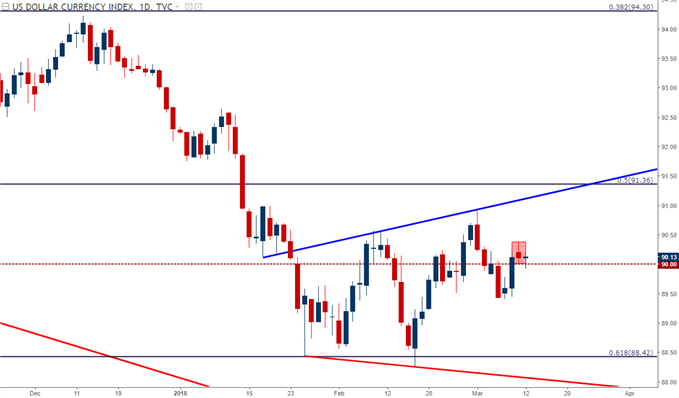Talking Points:
- This week’s economic calendar is relatively tame compared to the past couple of weeks; but coming more into focus is next week’s FOMC[1] rate decision, which is currently showing an 88.8% chance of a hike. This will be Jerome Powell’s first rate decision as the head of the bank, and this is an opportune time to get a feel for how Mr. Powell’s tenure atop the bank might take place.
- Before we get to next week’s widely-expected rate hike, we get inflation data out of the United States tomorrow morning, and this has been a hot-button around US Dollar price action. The Greenback is currently seeing range expansion ahead of the next two weeks’ outlay, and this has helped to craft a support test in EUR/USD[2] while GBP/USD[3] is testing shorter-term resistance. Also of interest is a longer-term setup in USD/JPY[4], which has provided enough support to quell the shorter-term sell-off, creating a second shorter-term symmetrical wedge formation.
If you’re looking for longer-term analysis on US Stocks, the Euro[5] or the U.S. Dollar, click here for our Trading Guides[6].
US Inflation Data This Week – FOMC Next Week
The next couple of weeks are lining up to be quite interesting for the US Dollar[7], particularly after last week’s robust NFP print. Non-Farm Payrolls blew through the expectation[8] of +205k to print at +313k; but lagging Average Hourly Earnings was a bit of a hindrance and the net price action result was a spinning top formation for Friday in DXY[9]. A spinning top is similar to a Doji in the fact that they’re both ‘indecision’ indicators, but the spinning top has a slightly wider body than what might show up in a Doji.
US Dollar Price Chart via ‘DXY’: Daily Time-Frame, Friday NFP Produces Spinning Top, 90.00 Support

Chart prepared by James Stanley[10]
The price action[11] that we saw last week around NFP helps to show how important inflation data is in the current context. Even a blowout on the headline number couldn’t elicit any significant strength in the Greenback, and the likely reason why is the buffer of that lagging AHE. Speaking to this theme, February saw a slight beat on the headline, +200k v/s an expectation of +180k, but the US Dollar struck a spate of strength that lasted for about a week; largely on the basis of a surprisingly strong Average Hourly Earnings print in that report. That number originally came-in at 2.9%, but was revised down to 2.8% on Friday. February Average Hourly Earnings disappointed by coming-in at 2.6% versus the expectation of 2.8%.
This is key because on next week’s calendar[12] is the Federal Reserve at



